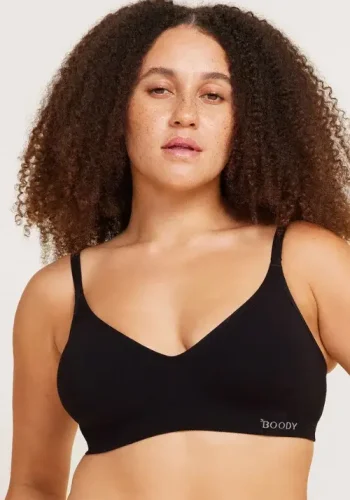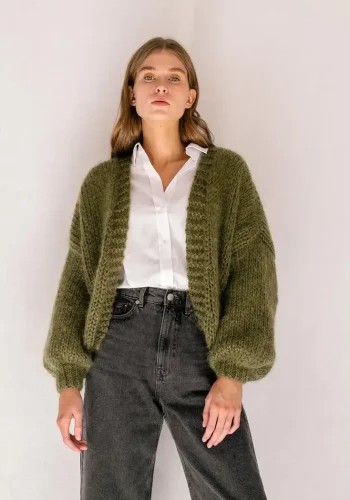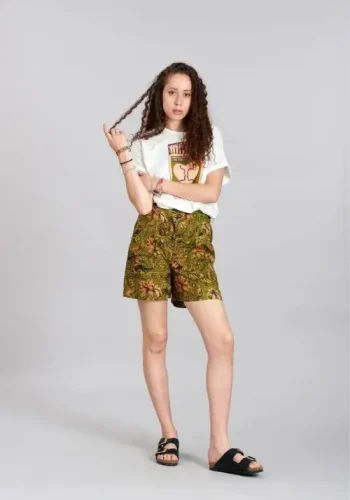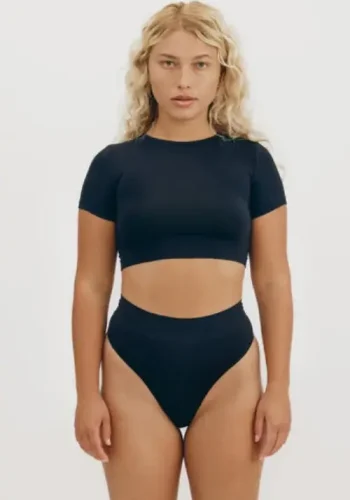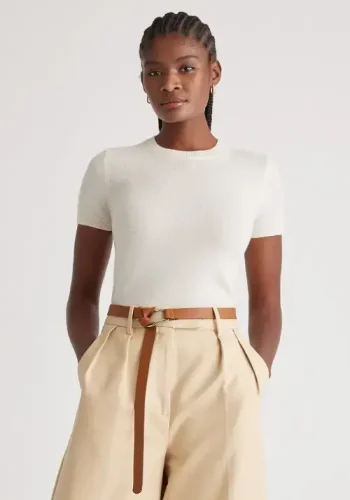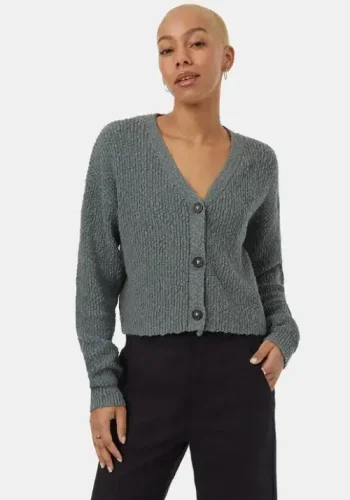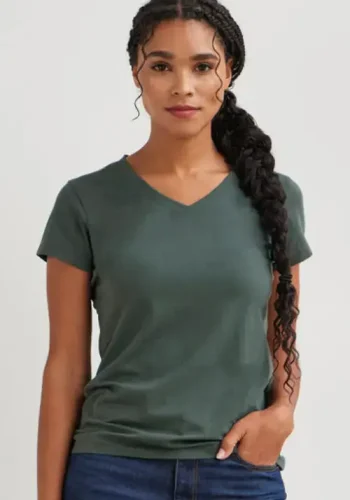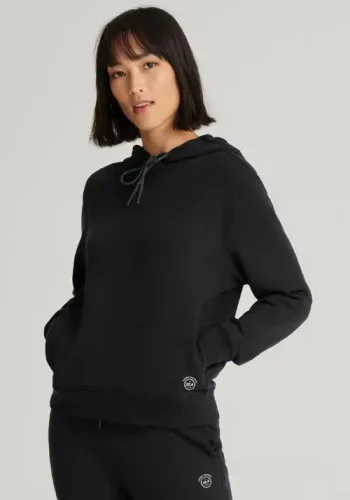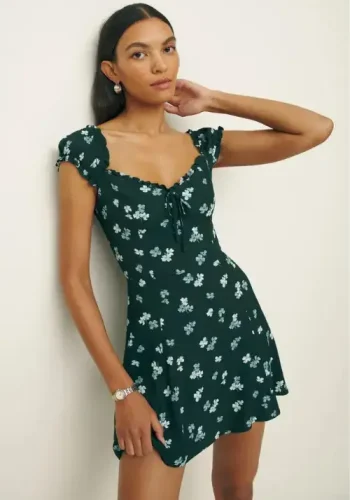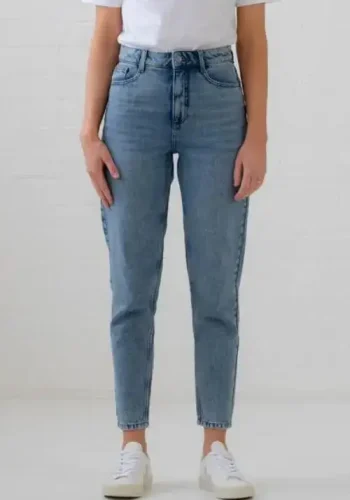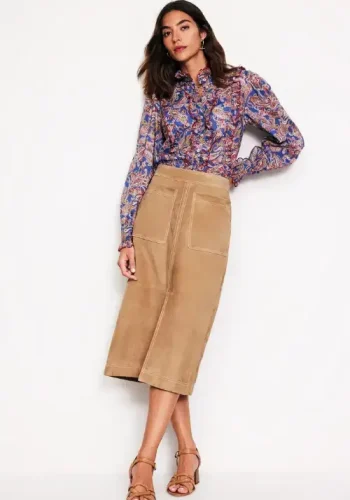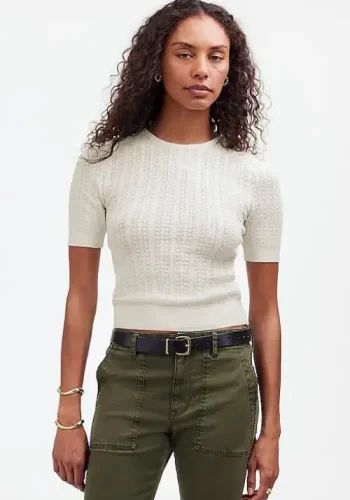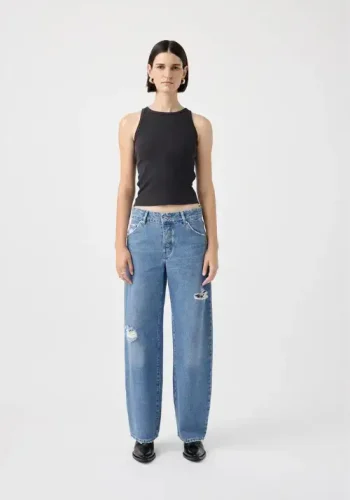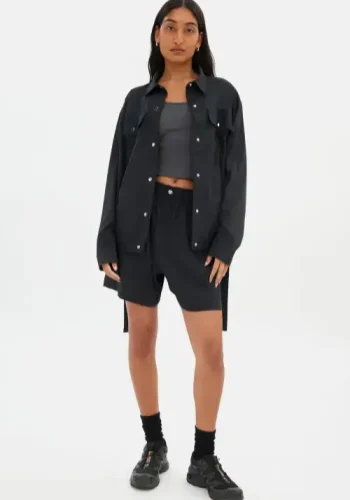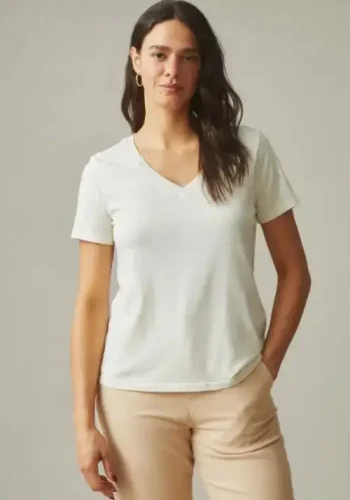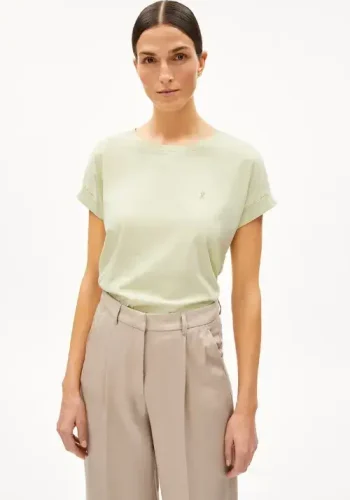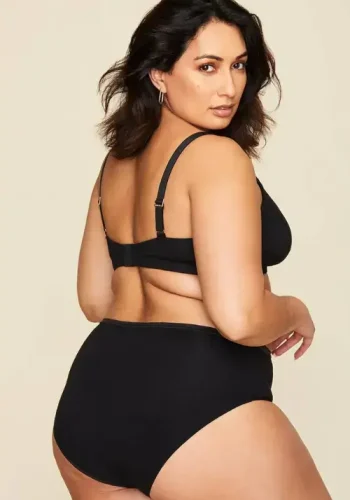- IN THIS ARTICLE
Sustainable clothing has quickly become more than just a trend. It’s a movement redefining the fashion industry.
With the growing demand for eco-friendly materials and ethically produced clothing, consumers are increasingly aware of the environmental impact their wardrobes have.
As fast fashion continues to contribute to pollution, waste, and unethical labor practices, the need for sustainable clothing alternatives has never been more urgent.
green clothing, affordable and practical, is not only possible but also within reach.
Whether you’re looking for sustainable clothing brands that offer organic cotton basics or ethical fashion brands with transparent supply chains, you don’t have to compromise your budget to make eco-conscious choices.
Here’s how you can embrace sustainable clothing, affordable options without breaking the bank.
What is Sustainable Fashion?
Sustainable fashion is a movement and process of fostering change in fashion products and the fashion system towards greater ecological integrity and social justice.
At its core, sustainable fashion emphasizes the use of eco-friendly materials, the implementation of ethical labor practices, and the reduction of waste throughout the production process.
This holistic approach to fashion production seeks to address the environmental and social impacts caused by the traditional textile industry, which often prioritizes profit over people and the planet.
Eco-friendly materials are central to sustainable clothing. These materials, such as organic cotton, recycled materials, and natural fibers, are cultivated or manufactured in ways that minimize harm to the environment.
For instance, GOTS-certified organic cotton is grown without the use of harmful pesticides, ensuring a lower environmental footprint and safer working conditions for farmers.
Additionally, recycled materials like recycled polyester or recycled plastic bottles help reduce the need for virgin resources, thus lessening the overall carbon footprint of fashion products.
Equally important are the ethical labor practices upheld by ethical fashion brands. Unlike fast fashion brands that often exploit cheap labor in unsafe working conditions, ethical clothing brands prioritize the well-being of their workers.
This includes ensuring fair wages, safe working environments, and respect for workers’ rights throughout the supply chain.
Brands that are Fair Trade Certified or operate in Fair Trade Certified factories are particularly noteworthy for their commitment to ethical practices.
Lastly, sustainable clothing is about reducing waste. This can involve designing for durability, encouraging clothing repairs, and using upcycled materials.
By focusing on longevity and circularity, sustainable clothing challenges the disposable culture fostered by fast fashion, which encourages consumers to buy cheap, low-quality garments that quickly end up in landfills.
The Environmental and Social Impact of Fashion

The fashion industry is one of the most polluting industries in the world. Fast fashion, known for its quick turnaround and cheap clothing, is a major contributor to the environmental damage we see today.
Fast fashion’s reliance on cheap, synthetic fabrics, such as polyester, results in massive carbon emissions and microplastic pollution in oceans.
Additionally, the constant demand for new styles leads to overproduction, which not only depletes natural resources but also generates enormous amounts of post-consumer waste.
According to studies, the clothing industry is responsible for approximately 10% of global carbon emissions, more than international flights and maritime shipping combined (SustainFashions, n.d.).
Moreover, the social impact of fast fashion cannot be ignored.
Many fast fashion brands operate under opaque supply chains that often involve unethical labor practices, including child labor and modern slavery.
Workers in these manufactures are frequently subjected to low wages, long hours, and unsafe working conditions.
In contrast, sustainable clothing brands strive to address these issues by advocating for ethical labor practices and transparency within their operations.
By using organic materials and recycled materials, and by supporting fair trade, sustainable clothing brands aim to minimize their environmental impact and ensure that their products contribute to a more equitable fashion industry.
For instance, brands that adhere to the Better Cotton Initiative or use GOTS-certified organic cotton demonstrate their commitment to reducing environmental harm and supporting sustainable agriculture.
Why Sustainable Fashion Often Costs More
One of the most common challenges faced by consumers interested in sustainable fashion is the higher price point of these garments compared to fast fashion. However, the increased cost of sustainable clothing is justified by several factors rooted in ethical and environmental responsibility.
Firstly, sustainable clothing brands often use high-quality basics and eco-friendly fabrics that are more expensive to produce.
For example, organic cotton requires more care and labor to cultivate than conventional cotton, leading to higher costs. Additionally, sustainable brands prioritize fair wages for their workers, which is reflected in the final price of the garment.
Unlike fast fashion brands that cut costs by underpaying their workers, ethical brands ensure that everyone involved in the production process is compensated fairly, contributing to the overall cost.
Another factor driving up the cost of sustainable clothing is the smaller scale of production.
Unlike fast fashion, which relies on mass production to keep prices low, sustainable brands often produce their collections in smaller quantities to reduce waste.
This slow fashion approach, while more environmentally friendly, results in higher per-unit costs.
Furthermore, sustainable brands invest in biodegradable packaging, carbon-neutral shipping methods, and other environmental initiatives that add to the overall expense but are crucial for reducing the environmental impact of fashion.
Debunking Myths: Can Sustainable Fashion Be Affordable?
When we think of sustainable fashion, the image that often comes to mind is one of steep price tags—clothing only accessible to those with deep pockets.
This widespread belief that sustainable clothing is always expensive stems from comparing it to the low costs of fast fashion brands.
However, the reality is more nuanced. While some sustainable clothing brands do carry a higher price tag, there are numerous affordable sustainable clothing brands that balance ethics, quality, and economy.
One of the most persistent myths is that affordable sustainable clothing doesn’t exist. This couldn’t be further from the truth.
The key is to shift our mindset: sustainable clothing is less about chasing the latest trends and more about investing in quality, longevity, and ethical supply network.
By embracing these sustainable practices, consumers can find affordable clothing options that align with both their values and their wallets.
Factors Driving Cost in Ethical Fashion
To understand the cost of sustainable clothing, it’s essential to consider what goes into producing these garments. Key factors driving up the cost include the use of Sustainable materials, ethical labor practices, and smaller production runs.
Eco-Friendly Materials: Sustainable fashion brands prioritize natural cotton, recycled polyester, and other natural materials that have a lower environmental impact. These sustainable materials are often more expensive to produce than conventional alternatives. For example, GOTS-certified green cotton is grown without harmful pesticides, protecting both the environment and farmers’ health. This investment in high-quality, eco-friendly materials translates into more durable and ethically made garments.
Fair Labor Practices: Unlike fast fashion brands that often exploit workers through poor wages and unsafe conditions, ethical clothing brands ensure that workers are paid ethical wages and work in safe environments. This commitment to ethical labor practices increases production costs but ensures that the people who make your clothes are treated with dignity—a value worth supporting.
Small-Scale Production: Sustainable fashion often follows the slow fashion model, focusing on quality over quantity. Smaller production runs reduce waste but can lead to higher costs per item. In contrast, fast fashion’s mass production lowers costs but results in significant post-consumer waste and lower-quality garments.
Value Over Time: Cost Per Wear
A compelling reason to invest in affordable sustainable clothing is the concept of cost per wear.
While a fast fashion item might be cheaper upfront, its low quality often means it won’t last long.
Conversely, a well-made piece from a sustainable brand may cost more initially, but its durability ensures it can be worn for years, significantly lowering the cost per wear.
For example, consider a $20 fast fashion t-shirt that you wear five times before it fades or loses shape.
The cost per wear is $4. Now, compare this to a $60 green cotton t-shirt from an ethical fashion brand that you wear 60 times. The cost per wear drops to just $1.
A significant saving over time. This shift in perspective, from short-term savings to long-term value, is central to embracing affordable sustainable fashion.
Moreover, sustainable clothing brands often focus on timeless designs rather than fleeting trends.
This means that the pieces you invest in remain stylish and functional for years, reducing the need for frequent wardrobe updates.
When you consider the quality, durability, and ethical benefits, the higher initial cost of sustainable clothing becomes an investment rather than an expense.
The Cost of Sustainable Fashion: Understanding the Price Tag
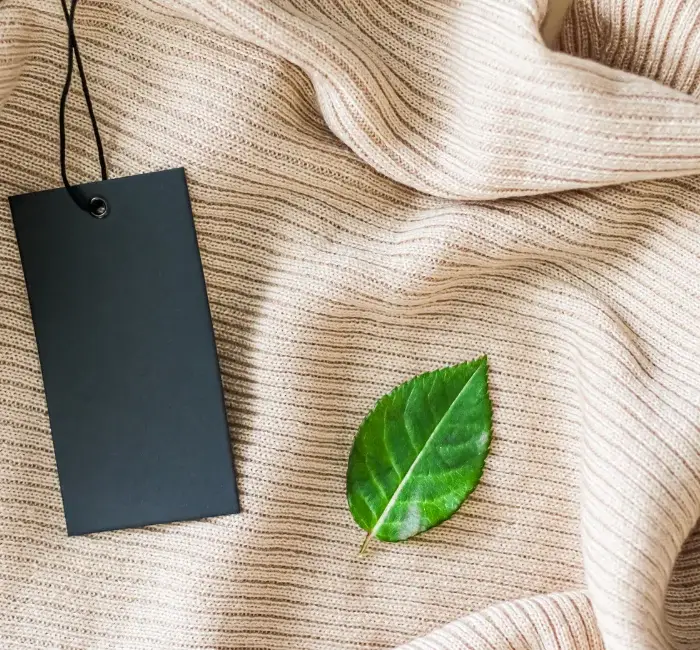
Sustainable fashion has garnered significant attention in recent years, not just for its ethical and environmental benefits but also for the cost associated with it.
Many consumers wonder why sustainable clothing often comes with a higher price tag compared to fast fashion alternatives.
The answer lies in the commitment to quality, fair practices, and eco-friendly materials that define sustainable clothing brands.
Eco-Friendly Materials: Eco-friendly fashion brands prioritize the use of organic materials, such as GOTS certified green cotton, recycled polyester, and natural fibers. These materials are more expensive to produce because they avoid harmful pesticides and chemicals, require more labor-intensive farming practices, and often involve certification processes that guarantee their sustainability. For instance, natural cotton is grown without synthetic pesticides, which protects the environment and the workers but also results in a higher production cost.
Ethical Labor Practices: A significant factor contributing to the cost of ethical style is the emphasis on ethical labor practices. Unlike fast fashion brands, which often exploit cheap labor in developing countries, sustainable brands ensure that all workers throughout their supply network are paid ethical wages and work in safe conditions. This commitment to ethical practices is reflected in the price of the garment. For example, a brand that operates in a Fair Trade Certified factory will inherently have higher production costs due to the fair compensation provided to its workers.
Smaller Production Runs: Eco-friendly fashion often aligns with the principles of slow fashion, focusing on smaller production runs to minimize waste and ensure high quality. This contrasts sharply with the mass production strategies of fast fashion, where economies of scale lower the cost per item. By producing fewer pieces, sustainable brands can maintain quality but at a higher cost per unit, which is passed on to the consumer.
Environmental Initiatives: Many sustainable fashion brands invest in environmental initiatives such as carbon offsetting, biodegradable packaging, and plastic-free packaging. These initiatives, while beneficial for the planet, also contribute to the overall cost of the product. Additionally, sourcing recycled materials like recycled cotton or recycled plastic bottles requires additional processing, which further adds to the cost.
The Problem with Fast Fashion: Why Cheap Isn’t Always Cheerful
Fast fashion has transformed the way we consume clothing, making trendy styles available at incredibly low prices.
However, this convenience comes at a significant environmental cost. The fashion industry is one of the largest polluters globally, and fast fashion is a major contributor to this crisis. The environmental impact of fast fashion is multifaceted, affecting everything from carbon footprint to post-consumer waste.
Environmental Impact
One of the most alarming aspects of fast fashion is its contribution to waste and pollution.
The industry’s focus on rapid production and disposable clothing has led to a staggering amount of textile waste.
Each year, millions of tons of clothing end up in landfills, where they can take decades to decompose, releasing harmful chemicals into the soil and waterways (Dean Clothing, n.d.).
Additionally, the production of these garments often relies on cheap, synthetic materials like polyester, which shed microplastics into the oceans with every wash. These microplastics are not only harmful to marine life but also enter the food chain, posing risks to human health.
Moreover, fast fashion’s reliance on cheap, non-renewable resources exacerbates its environmental footprint.
The production process is heavily water-intensive, particularly in the cultivation of conventional cotton, which requires vast amounts of water and pesticides.
In contrast, sustainable clothing brands prioritize eco-friendly materials such as green cotton and recycled polyester, which significantly reduce environmental harm.
However, the sheer scale of fast fashion production, driven by the demand for low-cost clothing, continues to overshadow these sustainable efforts.
Labor Concerns
Beyond its environmental impact, fast fashion is notorious for its unethical labor practices.
The industry’s business model thrives on the exploitation of cheap labor in developing countries, where workers are often subjected to dangerous working conditions, long hours, and meager wages.
The pressure to produce clothing quickly and cheaply has led to widespread human rights abuses, including child labor and forced labor.
In many cases, cheap fashion brands operate with little transparency, making it difficult to trace their supply chains and hold them accountable for these practices.
Factories in countries like Bangladesh, India, and Vietnam are frequently overcrowded and unsafe, with workers earning far below a living wage.
This exploitation is not just an unfortunate byproduct of the industry. It is central to the fast fashion model, where keeping costs low is prioritized over the well-being of workers.
In contrast, ethical clothing brands ensure that their workers are paid ethical wages and work in safe conditions.
Brands that are Fair Trade Certified or operate in Fair Trade Certified factories go a step further by promoting social equity and environmental sustainability.
Supporting these brands not only contributes to a more just fashion industry but also helps dismantle the systemic inequalities perpetuated by fast fashion.
Greenwashing in Fast Fashion
As consumers become more aware of the environmental and social impact of their purchases, fast fashion brands have begun adopting the language of sustainability.
However, much of this is little more than greenwashing. The practice of using misleading claims to appear more environmentally friendly than they actually are.
Terms like “eco-friendly” and “sustainable” are often used by fast fashion companies to market a small subset of their products, while the majority of their business continues to operate on unsustainable practices.
For example, many fast fashion brands have launched “conscious” or “sustainable” lines that feature garments made from recycled materials or natural cotton.
While these initiatives might seem promising, they often amount to little more than a marketing ploy.
The fundamental business model of fast fashion based on overproduction and rapid consumption remains unchanged.
This model is inherently unsustainable, as it encourages consumers to buy more and dispose of items quickly, perpetuating the cycle of waste and environmental degradation.
True sustainability requires a holistic approach that extends beyond the materials used in production. It involves rethinking the entire supply chain, from sourcing natural fibers to ensuring that workers are treated ethically and paid fairly.
Brands that engage in greenwashing undermine genuine efforts to create a more sustainable fashion industry, misleading consumers who are trying to make responsible choices.
How to Find Affordable Sustainable Fashion
Sustainability is no longer just a buzzword. It’s a necessary shift towards more conscious consumption.
However, a common misconception is that sustainable clothing is inherently expensive.
While it’s true that many sustainable clothing brands command higher prices due to their ethical practices and eco-friendly materials, it is entirely possible to build a stylish, sustainable wardrobe without breaking the bank.
Here’s how to navigate the world of affordable sustainable clothing with savvy strategies and smart choices.
Research and Due Diligence
The first step in finding affordable sustainable clothing brands is conducting thorough research.
The fashion industry is notorious for greenwashing, so it’s essential to distinguish genuinely sustainable brands from those merely claiming to be.
When researching, look for clear evidence of sustainability practices, including third-party certifications like Fair Trade, GOTS (Global Organic Textile Standard), and Bluesign.
These certifications indicate that a brand adheres to high environmental and social standards, from the sourcing of organic materials to ethical labor practices.
Fair Trade Certification: This guarantees that the products are produced in factories where workers receive fair pay and operate in safe working environments. Brands with this certification are committed to social equity and environmental sustainability.
GOTS Certified Organic Cotton: GOTS is one of the most stringent certifications for organic textiles, covering the entire supply chain, from the harvesting of raw materials to socially responsible manufacturing.
Bluesign: This certification focuses on reducing the environmental impact of textile production, ensuring that harmful chemicals are eliminated from the manufacturing process.
In addition to certifications, it’s important to assess a brand’s transparency. Ethical brands often provide detailed information about their supply chain, from where they source their natural materials to how they ensure fair labor practices. Transparency is key. If a brand is vague about its practices, it’s a red flag.
Affordable Alternatives to Fast Fashion
One of the most effective ways to embrace sustainable clothing without overspending is by exploring alternatives to traditional retail. Here are some strategies to help you shop sustainably on a budget:
Second-Hand Shopping: Thrifting has become a fashion-forward way to shop sustainably. Vintage stores, consignment shops, and online platforms like ThredUp and Poshmark offer a wide range of pre-loved garments that are often much cheaper than buying new. Not only does this extend the life of clothing, but it also reduces the demand for new production, thereby lessening your carbon footprint.
Clothing Swaps: Hosting or participating in a clothing swap is a fun and cost-effective way to refresh your wardrobe. By exchanging items with friends or community members, you can give your unwanted clothes a new home while discovering new pieces without spending a dime.
Shopping During Sales: Many sustainable brands offer seasonal sales or discount codes. Signing up for newsletters from your favorite brands can keep you informed about these deals. While shopping sales, focus on versatile, timeless pieces that can be worn across multiple seasons—this aligns with the slow fashion philosophy of buying less but better.
Building a Sustainable Wardrobe on a Budget
Transitioning to a more sustainable wardrobe doesn’t have to happen overnight. The key is to prioritize quality over quantity and to approach your wardrobe as an evolving collection rather than a constant rotation of new trends. Here’s how to get started:
Prioritize Basics and Essentials: Start by investing in high-quality basics that form the foundation of your wardrobe. Think neutral t-shirts, well-fitting jeans, and versatile outerwear. These items may cost more upfront, but they are designed to last, offering a lower cost-per-wear over time.
Start Small: You don’t need to replace your entire wardrobe at once. Begin by identifying the fast fashion items you wear most frequently and gradually replace them with more sustainable alternatives. For instance, swap out a cheaply-made t-shirt for one made from certified organic cotton or upgrade your worn-out sneakers to a pair made from recycled materials.
Mix and Match: To maximize your wardrobe, focus on pieces that can be mixed and matched to create multiple outfits. This approach not only saves money but also aligns with the principles of sustainable clothing by reducing the need for excessive consumption.
Mend and Care: Part of building a more sustainable wardrobe is taking good care of the clothes you already own. Learn basic mending skills to extend the life of your garments, and follow proper care instructions to prevent premature wear and tear. This not only reduces waste but also ensures you get the most out of each piece.
Top 24 Affordable Sustainable Fashion Brands
Finding affordable sustainable clothing brands can feel like searching for a needle in a haystack.
However, the good news is that more brands are emerging with a commitment to both affordability and sustainability, making it easier for conscious consumers to build a wardrobe that aligns with their values.
Below, we’ve curated a list of 24 brands that cater to different styles and budgets, ensuring you can look good, feel good, and do good for the planet all without breaking the bank.
For: Men, Women, Kids
Categories: Basics, Activewear, Loungewear
Price Range: $12 – $95
Sustainability: Organic bamboo, Oeko-Tex certified, recyclable packaging
Boody offers affordable basics made from organic bamboo, a highly renewable resource. The brand is dedicated to sustainability from production to packaging, using Oeko-Tex certified materials that are free from harmful chemicals.
For: Women
Categories: Casual Wear, Accessories
Price Range: $20 – $200
Sustainability: Fair trade, recycled materials, vegan
A digital marketplace featuring over 150 sustainable brands, Urbankissed offers everything from fashion to accessories. Each product is carefully vetted to meet high ethical and environmental standards.
For: Men, Women
Categories: Everyday Clothing, Footwear
Price Range: $40 – $150
Sustainability: GOTS certified, vegan options, carbon offsetting
Komodo UK is one of the pioneers of sustainable fashion in the UK, offering contemporary designs made with organic cotton and other eco-friendly materials. The brand also supports fair trade practices.
For: Men, Women
Categories: Basics, Underwear, Activewear
Price Range: $30 – $150
Sustainability: Organic cotton, GOTS certified, recycled materials, eco-friendly dyes, carbon-neutral shipping
Organic Basics prioritizes sustainability at every step, using GOTS certified organic cotton, recycled materials, and eco-friendly dyes. The brand is committed to reducing its carbon footprint with carbon-neutral shipping and ethical production practices.
For: Men, Women
Categories: Everyday Clothing, Home Goods
Price Range: $30 – $140
Sustainability: BCI cotton, fair trade certified, sustainable sourcing
Kotn offers affordable luxury with a focus on quality and sustainability. The brand works directly with cotton farmers in Egypt to create high-quality basics at a fair price.
For: Men, Women, Home
Categories: Everyday Clothing, Accessories
Price Range: $20 – $150
Sustainability: Organic cotton, eco-friendly packaging, transparent pricing
Quince’s direct-to-consumer model ensures premium quality at affordable prices. The brand offers timeless pieces made from sustainable materials like organic cotton and recycled polyester.
For: Men, Women, Kids
Categories: Everyday Clothing, Activewear, Accessories
Price Range: $30 – $120
Sustainability: Recycled materials, Tencel, ten trees planted per purchase
Tentree combines sustainable materials with a mission to plant ten trees for every item sold. Their clothing is stylish, functional, and designed for outdoor enthusiasts.
For: Men, Women
Categories: Basics, Workwear
Price Range: $30 – $150
Sustainability: Organic cotton, fair trade, natural dyes
Fair Indigo is dedicated to creating sustainable, high-quality basics and workwear that last. The brand’s commitment to fair trade ensures that their workers are paid fair wages and work in safe conditions.
For: Men, Women
Categories: Everyday Clothing, Footwear, Accessories
Price Range: $30 – $200
Sustainability: Recycled materials, fair wages, ethical factories
Everlane’s “Radical Transparency” approach allows customers to see the true cost behind every product. The brand is a go-to for minimalist, high-quality basics made ethically.
For: Men, Women
Categories: Footwear, Activewear
Price Range: $45 – $125
Sustainability: Natural materials, carbon neutral, recycled packaging
Allbirds revolutionized the footwear industry with its wool runners made from natural and sustainable materials. Their commitment to carbon neutrality extends to their entire supply chain.
For: Men, Women, Kids, Home
Categories: Vintage Clothing, Handmade Items
Price Range: $10 – $500
Sustainability: Supports small businesses, upcycled materials, handmade
Etsy is a global marketplace for unique and handmade items. Supporting independent sellers on Etsy often means supporting sustainable practices like upcycling and local craftsmanship.
For: Women
Categories: Casual Wear, Formal Wear
Price Range: $60 – $300
Sustainability: Recycled materials, sustainable fabrics, carbon offsetting
Reformation is known for its eco-chic designs that don’t compromise on style. The brand uses sustainable fabrics and prioritizes reducing waste through every stage of production.
For: Men, Women
Categories: Basics, Casual Wear
Price Range: $15 – $50
Sustainability: Fair trade, organic cotton, recycled materials
Yes Friends makes affordable ethical fashion a reality with their range of high-quality basics. The brand is committed to transparency and fair wages for all workers.
For: Women
Categories: Loungewear, Basics
Price Range: $40 – $150
Sustainability: Organic cotton, natural dyes, made in the USA
LA Relaxed offers luxurious, sustainable loungewear and basics made from organic and eco-friendly materials. The brand’s production is entirely local, ensuring ethical practices from start to finish.
For: Women, Kids
Categories: Everyday Clothing, Workwear
Price Range: $40 – $180
Sustainability: Organic cotton, fair trade, recycled materials
Boden is a British brand offering vibrant, high-quality clothing that’s made to last. Their commitment to sustainability includes using organic and recycled materials across their collections.
For: Women
Categories: Denim, Casual Wear
Price Range: $50 – $200
Sustainability: Fair trade, organic cotton, recycled materials
Madewell is beloved for its denim, but the brand also offers a wide range of sustainable clothing made with fair trade practices and eco-friendly fabrics.
For: Women
Categories: Casual Wear, Accessories
Price Range: $30 – $200
Sustainability: Ethical labor, sustainable materials, transparent pricing
ABLE is a mission-driven brand focused on ending generational poverty by providing jobs to women. Their clothing and accessories are ethically made with sustainable materials.
For: Men, Women
Categories: Denim, Casual Wear
Price Range: $100 – $250
Sustainability: Fair trade, organic cotton, recycled materials
Outland Denim is known for its premium denim made from sustainable materials. The brand supports survivors of human trafficking through fair employment practices.
For: Women
Categories: Activewear, Loungewear
Price Range: $30 – $100
Sustainability: Recycled materials, inclusive sizing, eco-friendly packaging
Girlfriend Collective offers inclusive, size-diverse activewear made from recycled materials. The brand’s transparency and commitment to sustainability make it a favorite among eco-conscious consumers.
For: Men, Women
Categories: Everyday Clothing, Outerwear
Price Range: $50 – $200
Sustainability: Made in the USA, organic cotton, fair wages
American Giant is known for their high-quality basics and outerwear made entirely in the USA. The brand focuses on durability and timeless designs, ensuring a long lifespan for each piece.
For: Men, Women
Categories: Basics, Underwear, Loungewear
Price Range: $25 – $100
Sustainability: Organic cotton, made in the USA, eco-friendly dyes
Harvest & Mill creates organic cotton basics that are 100% made in the USA. The brand is dedicated to sustainable sourcing and ethical production, offering timeless pieces for everyday wear.
For: Men, Women
Categories: Everyday Clothing, Casual Wear
Price Range: $30 – $150
Sustainability: Fair trade, organic cotton, recycled materials
ARMEDANGELS is a German brand that combines contemporary design with ethical practices. The brand’s use of organic cotton and fair trade principles ensures a high standard of sustainability.
For: Men, Women
Categories: Basics, T-Shirts
Price Range: $30 – $60
Sustainability: Organic cotton, fair trade, made in the USA
The Classic T-Shirt Company specializes in premium organic cotton t-shirts made entirely in the USA. Their commitment to quality and ethical production makes them a standout in sustainable fashion.
For: Men, Women
Categories: Casual Wear, Streetwear
Price Range: $40 – $150
Sustainability: Recycled materials, organic cotton, fair trade
Subset offers streetwear made with sustainability in mind. The brand uses recycled materials and natural cotton to create stylish, eco-friendly clothing that doesn’t compromise on design.
Sustainable Fashion for Every Budget
Sustainable fashion is often perceived as a luxury that only those with ample disposable income can afford.
However, this misconception is gradually fading as more budget-friendly options become available, and consumers learn to make more informed choices.
Whether you’re a student, a working professional, or simply someone who loves fashion, integrating sustainable practices into your wardrobe is possible at any budget. Here’s how you can embrace sustainable fashion without compromising on style or ethics.
Budget-Friendly Tips
Prioritize Quality Over Quantity: One of the key principles of sustainable fashion is investing in high-quality pieces that last longer. Instead of buying several cheap items that wear out quickly, focus on fewer, better-made garments. This reduces waste and ensures that each item in your wardrobe serves a purpose. Brands that use natural cotton or recycled materials offer products that are both durable and eco-friendly.
Shop During Sales: Many sustainable fashion brands offer seasonal sales or discounts. Sign up for newsletters to stay informed about these opportunities. Shopping during sales allows you to invest in high-quality pieces at a fraction of the cost. Additionally, look for brands that offer fair trade items, ensuring that your purchase supports ethical labor practices.
Build a Capsule Wardrobe: A capsule wardrobe is a collection of versatile pieces that can be mixed and matched to create various outfits. By focusing on timeless staples like high quality basics. Think classic t-shirts, jeans, and jackets you can minimize the need for frequent purchases, thus supporting the slow fashion movement.
Second-Hand and Vintage Finds
Second-hand shopping is one of the most affordable and sustainable ways to update your wardrobe. Thrift stores, consignment shops, and online platforms like ThredUp, Poshmark, and Depop offer a treasure trove of pre-loved clothing at budget-friendly prices. Here’s how to make the most of your thrifting experience:
Know What You Need: Before heading to a thrift store, make a list of items you’re looking for. This helps you stay focused and avoid impulse buys. Prioritize natural materials like cotton, wool, and linen, which tend to be more durable and environmentally friendly.
Check for Quality: Examine items carefully for signs of wear and tear. Look for sturdy seams, intact buttons, and high-quality fabrics. Second-hand shopping allows you to find well-made garments that might be too expensive to buy new.
Embrace Vintage: Vintage clothing is not only unique but also often made with higher-quality craftsmanship. Incorporating vintage pieces into your wardrobe adds character and ensures you’re wearing something that stands the test of time.
Customizing and Upcycling
Another effective way to embrace affordable sustainable fashion is through customization and upcycling. Breathing new life into old clothes not only extends their lifespan but also allows you to express your creativity. Here are some DIY tips to refresh your wardrobe:
Simple Alterations: Basic sewing skills can go a long way. Shortening a hem, taking in a waistline, or replacing buttons can make an old garment feel new again. These small changes are cost-effective and reduce the need for new purchases.
Dyeing and Printing: If you’re tired of a garment’s color, consider dyeing it a different shade or adding a print. Natural dyes made from plants are an eco-friendly option, and they can transform a plain piece into something vibrant and fresh.
Upcycle with Patches and Embroidery: Adding patches, embroidery, or even paint to your clothing can give it a unique, personalized touch. This is a great way to cover up stains or holes while making your garment one-of-a-kind.
Turn Old into New: Repurpose old clothes into something entirely different. For example, turn a worn-out pair of jeans into shorts, or transform an oversized shirt into a chic crop top. The possibilities are endless, and the results are sustainable.
Conclusion
The future of sustainable fashion lies in balancing affordability with responsible choices.
By investing in high-quality, ethically produced clothing, consumers can enjoy long-term benefits while reducing their environmental impact. Conscious consumption is not just a trend but a vital shift towards a more sustainable world.
We encourage you to explore the brands listed in this article and begin your journey towards a more mindful and eco-friendly wardrobe. Your choices today can help shape a better tomorrow for both fashion and the planet.

